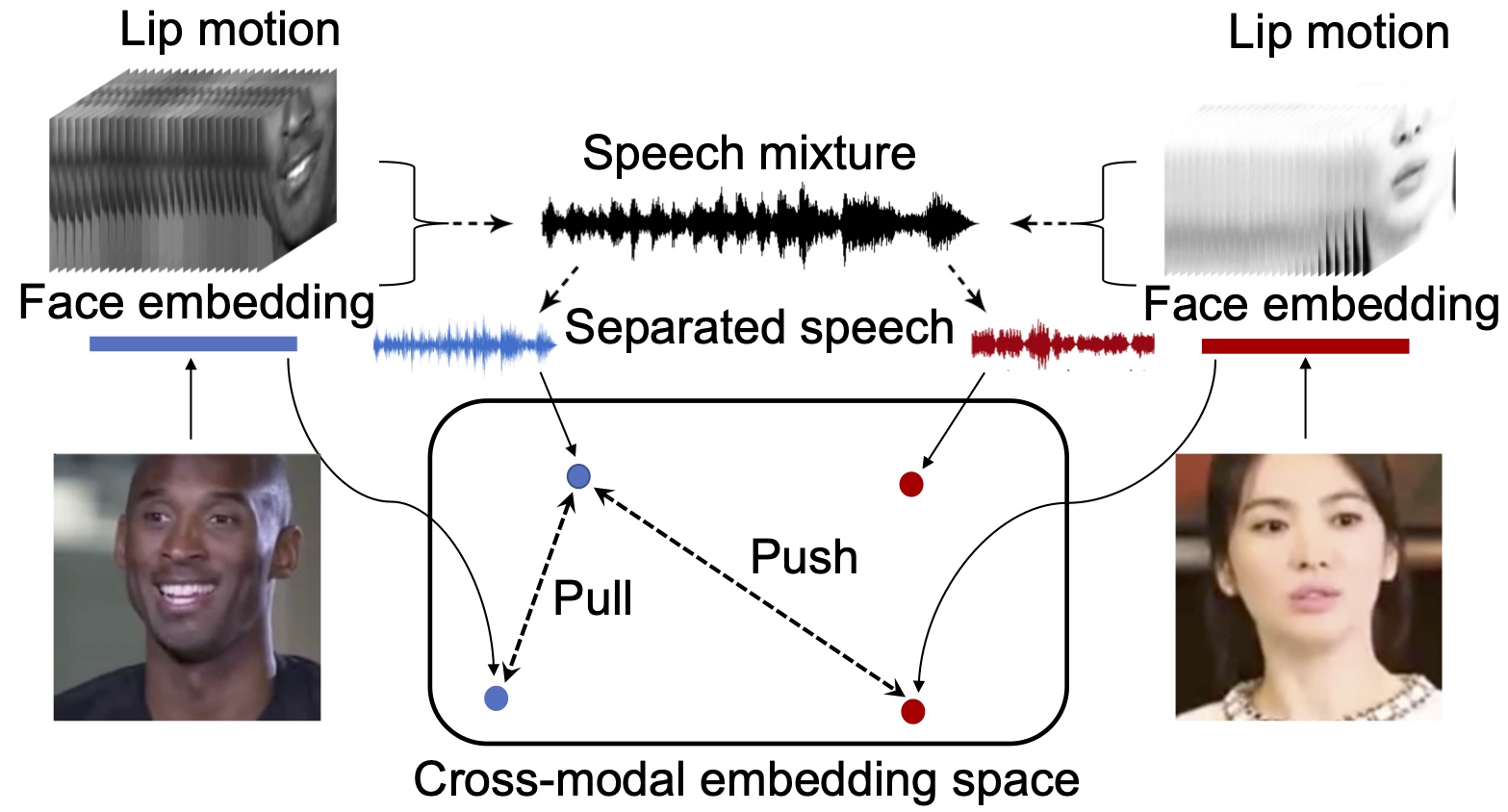This repository contains the code for VisualVoice. [Project Page]
VisualVoice: Audio-Visual Speech Separation with Cross-Modal Consistency
Ruohan Gao1,2 and Kristen Grauman1,2
1UT Austin, 2Facebook AI Research
In CVPR, 2021
If you find our data or project useful in your research, please cite:
@inproceedings{gao2021VisualVoice,
title = {VisualVoice: Audio-Visual Speech Separation with Cross-Modal Consistency},
author = {Gao, Ruohan and Grauman, Kristen},
booktitle = {CVPR},
year = {2021}
}
- Download the pre-trained models:
wget http://dl.fbaipublicfiles.com/VisualVoice/av-speech-separation-model/facial_best.pth
wget http://dl.fbaipublicfiles.com/VisualVoice/av-speech-separation-model/lipreading_best.pth
wget http://dl.fbaipublicfiles.com/VisualVoice/av-speech-separation-model/unet_best.pth
wget http://dl.fbaipublicfiles.com/VisualVoice/av-speech-separation-model/vocal_best.pth
- Preprocess the demo video using the following commands that convert the video to 25f/s, resample the audio to 16kHz, and track the speakers with a simple implementation based on a face detector. Using other advanced face tracker of your choice can lead to better separation results.
ffmpeg -i ./test_videos/interview.mp4 -filter:v fps=fps=25 ./test_videos/interview25fps.mp4
mv ./test_videos/interview25fps.mp4 ./test_videos/interview.mp4
python ./utils/detectFaces.py --video_input_path ./test_videos/interview.mp4 --output_path ./test_videos/interview/ --number_of_speakers 2 --scalar_face_detection 1.5 --detect_every_N_frame 8
ffmpeg -i ./test_videos/interview.mp4 -vn -ar 16000 -ac 1 -ab 192k -f wav ./test_videos/interview/interview.wav
python ./utils/crop_mouth_from_video.py --video-direc ./test_videos/interview/faces/ --landmark-direc ./test_videos/interview/landmark/ --save-direc ./test_videos/interview/mouthroi/ --convert-gray --filename-path ./test_videos/interview/filename_input/interview.csv
./
- Use the downloaded pre-trained models to test on the demo video.
python testRealVideo.py \
--mouthroi_root ./test_videos/interview/mouthroi/ \
--facetrack_root ./test_videos/interview/faces/ \
--audio_path ./test_videos/interview/interview.wav \
--weights_lipreadingnet pretrained_models/lipreading_best.pth \
--weights_facial pretrained_models/facial_best.pth \
--weights_unet pretrained_models/unet_best.pth \
--weights_vocal pretrained_models/vocal_best.pth \
--lipreading_config_path configs/lrw_snv1x_tcn2x.json \
--num_frames 64 \
--audio_length 2.55 \
--hop_size 160 \
--window_size 400 \
--n_fft 512 \
--unet_output_nc 2 \
--normalization \
--visual_feature_type both \
--identity_feature_dim 128 \
--audioVisual_feature_dim 1152 \
--visual_pool maxpool \
--audio_pool maxpool \
--compression_type none \
--reliable_face \
--audio_normalization \
--desired_rms 0.7 \
--number_of_speakers 2 \
--mask_clip_threshold 5 \
--hop_length 2.55 \
--lipreading_extract_feature \
--number_of_identity_frames 1 \
--output_dir_root ./test_videos/interview/
- Download the VoxCeleb2 dataset. The pre-processed mouth ROIs can be downloaded as follows:
# mounth ROIs for VoxCeleb2 (train: 1T; val: 20G; seen_heard_test: 88G; unseen_unheard_test: 20G)
wget http://dl.fbaipublicfiles.com/VisualVoice/mouth_roi_train.tar.gz
wget http://dl.fbaipublicfiles.com/VisualVoice/mouth_roi_val.tar.gz
wget http://dl.fbaipublicfiles.com/VisualVoice/mouth_roi_seen_heard_test.tar.gz
wget http://dl.fbaipublicfiles.com/VisualVoice/mouth_roi_unseen_unheard_test.tar.gz
# Directory structure of the dataset:
# ├── VoxCeleb2
# │ └── [mp4] (contain the face tracks in .mp4)
# │ └── [train]
# │ └── [val]
# │ └── [seen_heard_test]
# │ └── [unseen_unheard_test]
# │ └── [audio] (contain the audio files in .wav)
# │ └── [train]
# │ └── [val]
# │ └── [seen_heard_test]
# │ └── [unseen_unheard_test]
# │ └── [mouth_roi] (contain the mouth ROIs in .h5)
# │ └── [train]
# │ └── [val]
# │ └── [seen_heard_test]
# │ └── [unseen_unheard_test]
- Download the hdf5 files that contain the data paths, and then modify the hdf5 file accordingly by changing the paths to have the correct root prefix of your own.
wget http://dl.fbaipublicfiles.com/VisualVoice/hdf5/VoxCeleb2/train.h5
wget http://dl.fbaipublicfiles.com/VisualVoice/hdf5/VoxCeleb2/val.h5
wget http://dl.fbaipublicfiles.com/VisualVoice/hdf5/VoxCeleb2/seen_heard_test.h5
wget http://dl.fbaipublicfiles.com/VisualVoice/hdf5/VoxCeleb2/unseen_unheard_test.h5
(The code has been tested under the following system environment: Ubuntu 18.04.3 LTS, CUDA 10.0, Python 3.7.3, PyTorch 1.3.0, torchvision 0.4.1, face-alignment 1.2.0, librosa 0.7.0, av 8.0.3)
- Download the pre-trained cross-modal matching models as initialization:
wget http://dl.fbaipublicfiles.com/VisualVoice/cross-modal-pretraining/facial.pth
wget http://dl.fbaipublicfiles.com/VisualVoice/cross-modal-pretraining/vocal.pth
- Use the following command to train the VisualVoice speech separation model:
python train.py \
--name exp \
--gpu_ids 0,1,2,3,4,5,6,7 \
--batchSize 128 \
--nThreads 32 \
--display_freq 10 \
--save_latest_freq 500 \
--niter 1 \
--validation_on True \
--validation_freq 200 \
--validation_batches 30 \
--num_batch 50000 \
--lr_steps 30000 40000 \
--coseparation_loss_weight 0.01 \
--mixandseparate_loss_weight 1 \
--crossmodal_loss_weight 0.01 \
--lr_lipreading 0.0001 \
--lr_facial_attributes 0.00001 \
--lr_unet 0.0001 \
--lr_vocal_attributes 0.00001 \
--num_frames 64 \
--audio_length 2.55 \
--hop_size 160 \
--window_size 400 \
--n_fft 512 \
--margin 0.5 \
--weighted_loss \
--visual_pool maxpool \
--audio_pool maxpool \
--optimizer adam \
--normalization \
--tensorboard True \
--mask_loss_type L2 \
--visual_feature_type both \
--unet_input_nc 2 \
--unet_output_nc 2 \
--compression_type none \
--mask_clip_threshold 5 \
--audioVisual_feature_dim 1152 \
--identity_feature_dim 128 \
--audio_normalization \
--lipreading_extract_feature \
--weights_facial ./pretrained_models/cross-modal-pretraining/facial.pth \
--weights_vocal ./pretrained_models/cross-modal-pretraining/vocal.pth \
--lipreading_config_path configs/lrw_snv1x_tcn2x.json \
--data_path hdf5/VoxCeleb2/ \
|& tee logs.txt
- Use the following command to test on a synthetic mixture:
python test.py \
--audio1_path /YOUR_DATASET_PATH/VoxCeleb2/audio/seen_heard_test/id06688/akPwstwDxjE/00023.wav \
--audio2_path /YOUR_DATASET_PATH/VoxCeleb2/audio/seen_heard_test/id08606/0o-ZBLLLjXE/00002.wav \
--mouthroi1_path /YOUR_DATASET_PATH/VoxCeleb2/mouth_roi/seen_heard_test/id06688/akPwstwDxjE/00023.h5 \
--mouthroi2_path /YOUR_DATASET_PATH/VoxCeleb2/mouth_roi/seen_heard_test/id08606/0o-ZBLLLjXE/00002.h5 \
--video1_path /YOUR_DATASET_PATH/VoxCeleb2/mp4/seen_heard_test/id06688/akPwstwDxjE/00023.mp4 \
--video2_path /YOUR_DATASET_PATH/VoxCeleb2/mp4/seen_heard_test/id08606/0o-ZBLLLjXE/00002.mp4 \
--num_frames 64 \
--audio_length 2.55 \
--hop_size 160 \
--window_size 400 \
--n_fft 512 \
--weights_lipreadingnet pretrained_models/lipreading_best.pth \
--weights_facial pretrained_models/facial_best.pth \
--weights_unet pretrained_models/unet_best.pth \
--weights_vocal pretrained_models/vocal_best.pth \
--lipreading_config_path configs/lrw_snv1x_tcn2x.json \
--unet_output_nc 2 \
--normalization \
--mask_to_use pred \
--visual_feature_type both \
--identity_feature_dim 128 \
--audioVisual_feature_dim 1152 \
--visual_pool maxpool \
--audio_pool maxpool \
--compression_type none \
--mask_clip_threshold 5 \
--hop_length 2.55 \
--audio_normalization \
--lipreading_extract_feature \
--number_of_identity_frames 1 \
--output_dir_root test
- Evaluate the separation performance.
python evaluateSeparation.py --results_dir test/id06688_akPwstwDxjE_00023VSid08606_0o-ZBLLLjXE_00002
-
Audio-Visual speech separation model tailored to 2 speakers (with context): see subdirectory av-separation-with-context/.
-
Audio-Visual speech enhancement code: see subdirectory av-enhancement.
Some of the code is borrowed or adapted from Co-Separation. The code for the lip analysis network is adapted from Lipreading using Temporal Convolutional Networks.
The majority of VisualVoice is licensed under CC-BY-NC, however portions of the project are available under separate license terms: license information for Lipreading using Temporal Convolutional Networks is available at https://github.com/mpc001/Lipreading_using_Temporal_Convolutional_Networks/blob/master/LICENSE.
